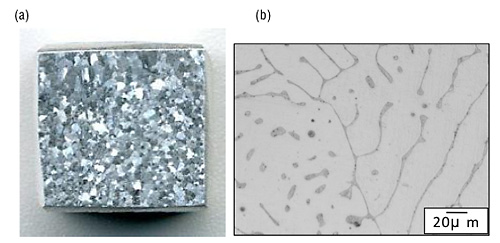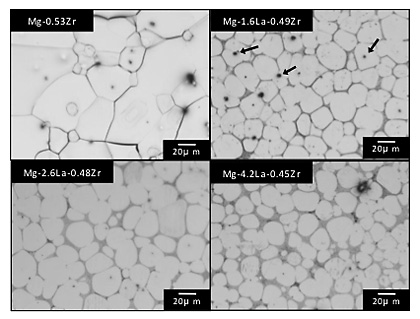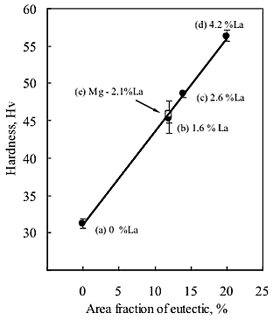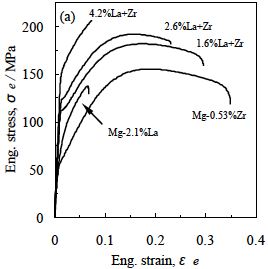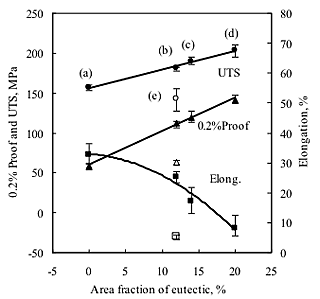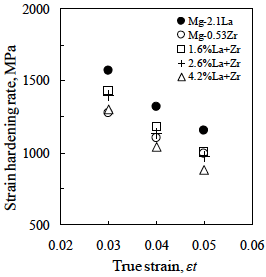The light density of magnesium is the prime reason behind the development of magnesium alloys for structural applications since they can be used to improve the fuel efficiency of mobile crafts, reducing CO2 emissions to lower the environment impact. The equilibrium phase diagram of the Mg-La system includes a thermally stable, hard Mg12La phase and almost all solute lanthanum solidifies as a hard eutectic Mg12La phase in the magnesium-rich side of the system. If the refinement and dispersion of the Mg12La phase within the structure can be achieved by structure modification, the mechanical properties will be enhanced. This may offer the possibility of using lanthanum for high-temperature structural alloys. Zirconium has an exceptional grain-refining capability for magnesium, and zirconium-refined alloys provide a good combination of ambient and elevated temperature properties. Therefore, the microstructure was examined and tensile tests performed for the cast Mg-La and Mg-La-Zr alloys. Lanthanum showed a mild grain refinement effect on magnesium, generating coarse equiaxed grains in the casting. While the microstructure within the equiaxed grain contained the primary Mg dendrites and eutectic regions as shown in Fig. 1, an addition of zirconium to the Mg-La alloys transformed coarse primary ![]() -Mg dendrites into fine globular grains surrounded by eutectic regions (Fig. 2). Only a few tenths of percent of solute zirconium (0.3-0.5%) in magnesium produces exceptional grain refinement in casting and moreover as illustrated in Fig. 2, the combination of lanthanum and zirconium exerted a much greater grain refining effect in comparison with only a zirconium addition. For example, with a combination of lanthanum and zirconium, the primary
-Mg dendrites into fine globular grains surrounded by eutectic regions (Fig. 2). Only a few tenths of percent of solute zirconium (0.3-0.5%) in magnesium produces exceptional grain refinement in casting and moreover as illustrated in Fig. 2, the combination of lanthanum and zirconium exerted a much greater grain refining effect in comparison with only a zirconium addition. For example, with a combination of lanthanum and zirconium, the primary ![]() -Mg grain size was 21
-Mg grain size was 21 ![]() m at 1.6 %La, which is less than half the grain size of the Mg-0.53Zr.
m at 1.6 %La, which is less than half the grain size of the Mg-0.53Zr.
The hardness increased linearly with an increase in eutectic amount as shown in Fig. 3. Regardless of the differences in microstructure between the Mg-2.1La (Fig. 1) and the alloys with a zirconium addition (Fig. 2), all hardness values are in accord with the area fraction of the eutectic. This increased the values of 0.2%proof strength and UTS with lanthanum content. In addition, with change in grain size tensile properties for Mg-La-Zr alloys improved significantly in comparison with the binary Mg-La alloys of comparative lanthanum content. Fig. 4 shows representative tensile curves for cast Mg-2.1La, Mg-0.53Zr, and Mg-La-Zr alloys. As can be seen in stress-strain curves, strain hardening increased with lanthanum content, reflecting the increase in hardness. The results of the tensile test are illustrated in Fig. 5. For Mg-La-Zr alloys, the 0.2%proof strength increased linearly with the area fraction of the eutectic from 58 MPa (0%La) to 181MPa (4.2%La) and the tensile strength from 157 to 207 MPa, while the value of elongation progressively decreased owing to an increase in eutectic Mg12La compound in the structure. For the Mg-2.1La alloy with no zirconium addition, the values of 0.2% proof strength, UTS, and elongation were significantly lower (44%, 22%, and 79% lower, respectively) than those of Mg-La-Zr alloys having the corresponding value of area fraction of the eutectic (Fig. 5). Fracture occurred owing to the decohesion between the primary Mg grains and eutectic Mg12La phases. An increase in the eutectic regions thus leads to a reduction in ductility by means of crack propagation through the regions. As shown in Fig. 6 the strain hardening rate of the Mg-2.1La alloy remained the highest among the alloys. It clearly indicates in summary, the combined effects of lanthanum and zirconium on grain refinement as well as the hardness increase due to lanthanum significantly enhance the mechanical properties of Mg-La-Zr alloys.
